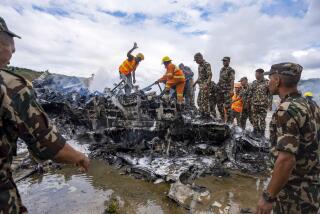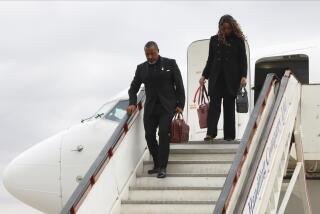50 of 51 Die as Plane Crashes Near Timbuktu
- Share via
BAMAKO, Mali — A Soviet-built passenger turboprop of Air Mali crashed Friday soon after taking off from the desert outpost of Timbuktu, killing all but one of the 51 people aboard, officials at the airline’s headquarters here reported. The surviving passenger was said to be in critical condition.
Sketchy reports said that a dozen or so foreigners were among the dead, but the African airline did not release the passenger list for the domestic flight, which contained only last names of those aboard.
U.S. Embassy official Dave Kyzner said a few Americans were among the dead. Other reports said at least five of the victims were from international relief agencies working in refugee camps in drought-stricken areas northeast of Bamako.
‘Foreign-Sounding Names’
Kyzner said there were “14 or 15 foreign-sounding names” on the passenger list but that positive identification is impossible at this point.
He added that access to and communication with Timbuktu is beiing hampered by violent sandstorms that have raged for 10 days in the Sahara.
The official government radio, however, identified one of those who died as Attaher Maiga, a government minister under the regime of the late President Modibo Keita in the 1960s.
The twin turbo-prop Antonov-24, a 50-seat craft, was en route from Gao, in the eastern part of this sub-Saharan nation to Bamako, via Timbuktu and Mopti.
Timbuktu, fabled as a Sahara caravan terminal at the northern bend of the Niger River, is these days a dusty, frequently inaccesible place with a population of about 20,000.
Niger River Trips
Besides the twice-weekly, three-hour flights such as the one that crashed Friday, travelers reach Timbuktu by Niger River steamer from Bamako--a voyage distinguished by crowded quarters and a clatter of tribal and Western cultures. There are also smaller boats, where passengers take the chance of parasite contamination if splashed by the polluted waters of the Niger.
Timbuktu, a 1,000-year-old hub, was once a trading capital on the West African gold and salt caravan routes. After reaching its height of influence under the Mali Empire of the 13th through 16th centuries. Now, it is reduced to two hotels, two mosques and some colonial-period buildings that dominate adobe mud-hut houses.
Still, Timbuktu is a popular site for foreign tourists, some of whom make the trip to get their passports stamped at the local police station, spend the night and fly back to Bamako.
Plane Turned Back
Air Mali officials said the Antonov developed engine trouble shortly after takeoff Friday morning and had turned back to Timbuktu. But the engine caught fire and exploded two miles from the airport.
More to Read
Sign up for Essential California
The most important California stories and recommendations in your inbox every morning.
You may occasionally receive promotional content from the Los Angeles Times.













